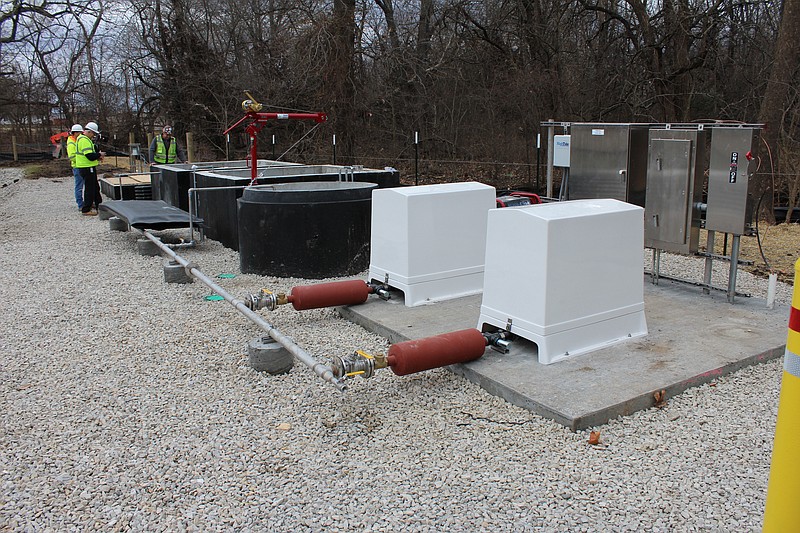Missouri American Water finished a new wastewater treatment system for the Hickory Hills subdivision, located just outside California's city limits, which will begin operation tomorrow.
Hickory Hills lies just to the west of California High School, right off Business 50. The new wastewater treatment system was installed next to the lagoon located directly behind the subdivision's housing on Janet Boulevard. The property's sewer and water service was acquired by Missouri American Water in late 2015, after previously being owned by the Hickory Hills Water and Sewer System.
The new system is a Triplepoint NitrOx system, which helps to regulate temperatures so bacteria can effectively grow and consume ammonia during the coldest winter months cost-effectively. The system is also low maintenance and simple to operate.
From the lagoon, wastewater will flow through the system, removing the ammonia and separating any solids. It'll then be chlorinated and dechlorinated to disinfect and kill germs, leaving basically clean water meeting ammonia limits running back into the creek.
The subdivision's wastewater system wasn't meeting current permit limits, said Bob Goeltz, Senior Project Engineer with Missouri American Water. Statewide, the Department of Natural Resources is implementing more restrictions on how much ammonia can be put into streams. Goeltz said Missouri American Water had to come in to bring things up to current standards, both with the subdivision's collection system and sewers and wastewater treatment system.
Goeltz said the company has done a lot of work on the wastewater collection system and sewers in line with these new limits. Some of this work, he said, was to prevent water leaks into the sewers, which could overwhelm the wastewater treatment plant.
"(This happens) during rain events or any storm water that would come into the system," Aaron Lachowicz, Operations Supervisor with Missouri American Water, said. "We went through and did a lot of pipe work in the collection to eliminate as much of the storm water as we could."
Goeltz said along with this, they installed new piping in the nearby creek, replaced sewer collection mains and reduced the flow rate as a result. Missouri American Water also did some improvement on the existing lagoon.
"The lagoon has been here since day one, and it was full of solids," Goeltz said.
Step one was to remove those solids, he said. Additionally, work was done to stabilize the lagoon banks, which were starting to slide in due to a lack of maintenance. Goeltz said they then worked with the company's engineers to come up with a plan ensuring they'd meet current and future limits, which are close to going into effect. However, he said the project is actually ahead of schedule.
"We actually have until the end of 2020 to meet the ammonia limits," Goeltz said.
The project was funded by Missouri American Water, with rates approved by the state. Missouri American Water has put roughly $750,000, on the wastewater side of things, into the project, Goeltz said. Missouri American Water owns more than 70 wastewater treatment facilities throughout the state as a private firm, all but one of which are on a single rate tariff, or fixed cost, rate system.
"Whenever we have an upgrade at one of the plants, it's spread across all of them and it goes through the Public Service Commission to have the approval of the rates," Goeltz said.
Once the system starts operation, it'll need some time to grow bacteria to break down organic materials and ammonia, Goeltz said. With the colder weather, it will probably take until the middle or end of February until the system is removing ammonia to a level reflecting the new DNR restrictions.
Along with this new system, Goeltz said Missouri American Water continues to work on upgrades on the water service side of the equation.
"The wastewater side is really important because you don't want to pollute the stream or anything else, but the water side is a more day-to-day critical item," Goeltz said. "We're doing a lot of upgrades. The quality of the distribution system for the water to the houses was in very poor shape, to say the least."
They'll continue adding some additional water capacity and pressure, having already stabilized the situation from before where water pressure to the residents of Hickory Hills was insufficient.

